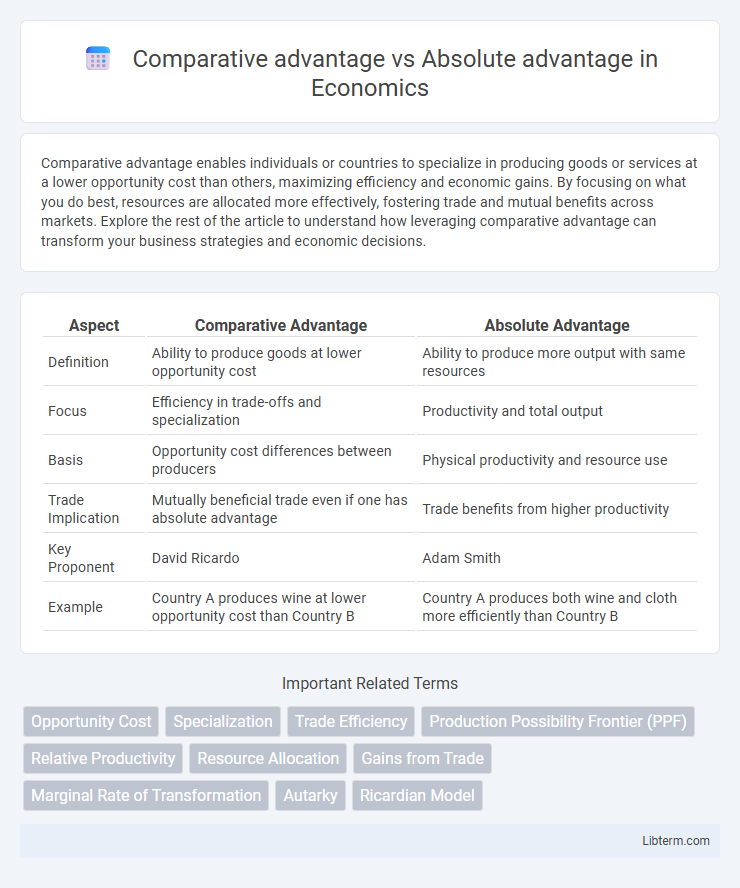Comparative advantage enables individuals or countries to specialize in producing goods or services at a lower opportunity cost than others, maximizing efficiency and economic gains. By focusing on what you do best, resources are allocated more effectively, fostering trade and mutual benefits across markets. Explore the rest of the article to understand how leveraging comparative advantage can transform your business strategies and economic decisions.
Table of Comparison
| Aspect | Comparative Advantage | Absolute Advantage |
|---|---|---|
| Definition | Ability to produce goods at lower opportunity cost | Ability to produce more output with same resources |
| Focus | Efficiency in trade-offs and specialization | Productivity and total output |
| Basis | Opportunity cost differences between producers | Physical productivity and resource use |
| Trade Implication | Mutually beneficial trade even if one has absolute advantage | Trade benefits from higher productivity |
| Key Proponent | David Ricardo | Adam Smith |
| Example | Country A produces wine at lower opportunity cost than Country B | Country A produces both wine and cloth more efficiently than Country B |
Introduction to Comparative and Absolute Advantage
Comparative advantage occurs when a country can produce a good at a lower opportunity cost than another, driving efficient resource allocation and trade benefits. Absolute advantage refers to the ability of a country to produce more of a good with the same resources compared to others. Understanding the distinction between these concepts is crucial for analyzing international trade patterns and economic specialization.
Defining Comparative Advantage
Comparative advantage refers to the ability of an individual, firm, or country to produce a good or service at a lower opportunity cost compared to others, enabling more efficient allocation of resources. This concept highlights specialization based on relative efficiency rather than absolute production capacity. Understanding comparative advantage helps explain trade patterns and benefits despite differences in absolute advantage.
Understanding Absolute Advantage
Absolute advantage refers to a country's ability to produce a good or service more efficiently than another country, using fewer resources or less time. This concept highlights the productivity differences that lead one nation to outperform others in the production of specific goods. Understanding absolute advantage helps explain why countries specialize in certain industries to maximize output and economic efficiency.
Key Differences Between Comparative and Absolute Advantage
Comparative advantage occurs when a country produces goods at a lower opportunity cost compared to others, whereas absolute advantage exists when a country produces goods more efficiently using fewer resources. Key differences include that comparative advantage emphasizes relative efficiency and trade benefits, while absolute advantage highlights overall productivity. Understanding these distinctions explains international trade dynamics and specialization benefits.
Historical Context and Economic Theories
Absolute advantage, introduced by Adam Smith in the 18th century, emphasizes a country's ability to produce goods more efficiently than others, forming the foundation of classical economics. Comparative advantage, developed by David Ricardo in the early 19th century, refines this idea by demonstrating that even if one nation lacks absolute efficiency, it benefits from specializing in goods with the lowest opportunity cost, driving gains from trade. These theories underpin modern international trade, explaining patterns of specialization, production, and economic interdependence throughout history.
Real-World Examples of Comparative Advantage
Countries like Bangladesh excel in textile production due to low labor costs, exemplifying comparative advantage, while the United States leads in technology and innovation with higher productivity. Comparative advantage drives international trade by encouraging nations to specialize in goods where they have lower opportunity costs, even if they lack absolute advantage. This specialization fosters global economic efficiency, as seen in China's dominance in electronics manufacturing despite higher absolute costs in some inputs.
Real-World Examples of Absolute Advantage
Absolute advantage refers to a country's ability to produce a good or service more efficiently than another nation, using fewer resources or less time. For example, Saudi Arabia holds an absolute advantage in oil production due to its vast reserves and low extraction costs, while the United States demonstrates absolute advantage in aerospace manufacturing with advanced technology and skilled labor. Understanding these real-world examples highlights how absolute advantage shapes global trade patterns and resource allocation.
Impact on International Trade and Global Markets
Comparative advantage drives international trade by encouraging countries to specialize in producing goods with the lowest opportunity costs, enhancing global efficiency and maximizing total output. Absolute advantage influences trade by enabling nations to produce certain goods more efficiently than others, but it does not solely determine trade patterns without considering comparative advantage. Together, these concepts shape global markets by guiding resource allocation, trade flows, and competitive dynamics among countries.
Limitations and Criticisms of Each Concept
Comparative advantage assumes constant opportunity costs and perfect mobility of resources, which often do not reflect real-world complexities such as transportation costs and trade barriers. Absolute advantage overlooks the benefits of specialization and trade when one country is less efficient in producing all goods, limiting its practical application in diverse economies. Both concepts face criticism for ignoring factors like economies of scale, technological change, and the dynamic nature of international trade.
Conclusion: Strategic Importance in Economics
Comparative advantage emphasizes the efficiency of producing goods at a lower opportunity cost, driving specialization and trade benefits among nations, while absolute advantage focuses on producing goods with fewer resources. The strategic importance in economics lies in leveraging comparative advantage to maximize global resource allocation and economic welfare, even if one country holds an absolute advantage in all products. Understanding and applying comparative advantage enables countries to create sustainable competitive strategies, optimize production, and enhance international trade dynamics.
Comparative advantage Infographic

 libterm.com
libterm.com